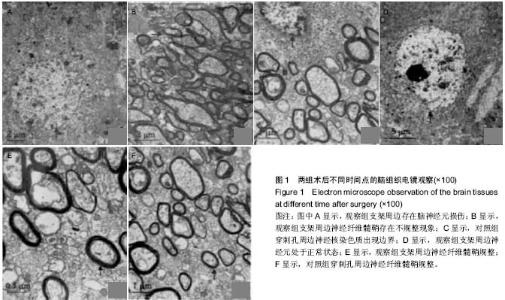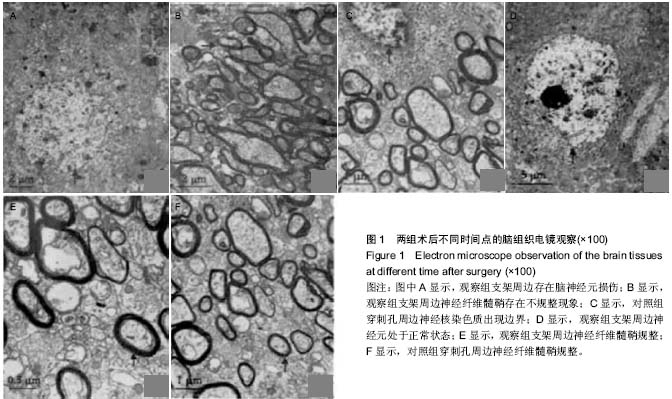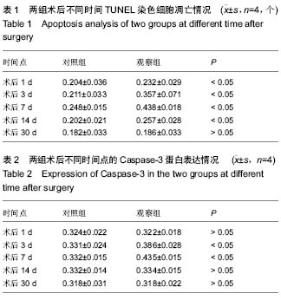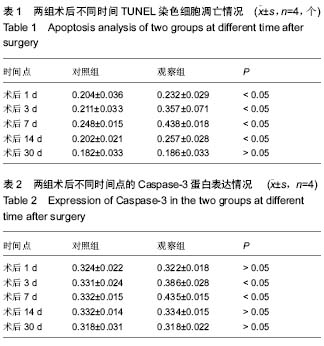| [1] 陈兴泳,唐洲平,唐荣华,等.胶原蛋白-硫酸肝素生物支架植入猪脑内凋亡相关蛋白的表达及意义[J].中华实验外科杂志, 2009, 26(6):758-760.
[2] 唐洲平,陈兴泳,唐荣华,等.胶原蛋白-硫酸肝素生物支架植入猪脑内生物相容性研究[J].中华医学杂志,2009,89(15): 1075- 1077.
[3] 陈兴泳,唐荣华,唐洲平,等.神经干细胞与胶原蛋白-硫酸肝素生物支架生物相容性研究[J].中国康复医学杂志,2008,23(2): 135-137,插1.
[4] 唐洲平,陈兴泳,谢雪微,等.胶原蛋白-硫酸肝素生物支架生物相容性研究[J].中华实验外科杂志,2008,25(3):365-367.
[5] 王树森,胡蕴玉,罗卓荆,等.Schwann细胞与硫酸肝素-胶原蛋白支架材料的复合[J].神经解剖学杂志,2005,21(2):175-179.
[6] 王树森,胡蕴玉,罗卓荆,等.嗅鞘细胞在硫酸肝素-胶原蛋白支架材料中复合的研究[J].中国脊柱脊髓杂志,2004,14(9):538-541.
[7] 李晓龙,穆长征,马云胜,等.胶原蛋白-硫酸肝素神经生物支架材料的制备[J].中国组织工程研究与临床康复,2011,15(12): 2125-2128.
[8] 陈兴泳,孟祥武,谢雪微,等.胶原蛋白复合硫酸肝素生物支架材料研制及其扫描电镜观察[J].中国误诊学杂志,2007,7(12): 2684-2687.
[9] 于德军.胶原蛋白-硫酸肝素支架细胞相容性的实验研究[D].哈尔滨医科大学,2009.
[10] 张挺.胶原蛋白-硫酸肝素支架材料的生物安全性的实验研究[D].哈尔滨医科大学,2009.
[11] 梅敏杰.不同类型脑血管支架材料的特点及临床应用[J].中国组织工程研究,2014,18(25):4057-4061.
[12] 金秀芬,徐艳杰.脑血管置入材料的生物相容性及并发症[J].中国组织工程研究与临床康复,2011,15(42):7931-7934.
[13] 官昌伦,石国霰,李琴,等.脑血管支架置入后的并发症及其预防[J].中国组织工程研究与临床康复,2010,14(9):1681-1684.
[14] 刘博,吴邦理,张学虎,等.脑血管支架的临床应用及其并发症[J].中国组织工程研究与临床康复,2009,13(39):7747-7750.
[15] 瞿浩,李玫,袁萍,等.可降解脑血管支架材料生物相容性的系统评价[J].中国组织工程研究与临床康复,2011,15(42):7881-7884.
[16] Tan Q,Chen B,Yan X,et al.Promotion of diabetic wound healing by collagen scaffold with collagen‐binding vascular endothelial growth factor in a diabetic rat model.J Tissue Eng Regen Med.2014;8(3):195-201.
[17] Yang HS,La WG,Park J,et al.Efficient Bone Regeneration Induced by Bone Morphogenetic Protein-2 Released from Apatite-Coated Collagen Scaffolds.J Biomater Sci Polym Ed.2012;23(13):1659-1671.
[18] 赵福海,刘剑刚,王欣,等.莪术组分涂层支架预防猪冠状动脉再狭窄的研究[J].中华老年心脑血管病杂志,2012,14(8):859-862.
[19] Qi Y,Zhao T,Xu K,et al.The restoration of full-thickness cartilage defects with mesenchymal stem cell(MSCs) loaded and cross-linked bilayer collagen scaffolds on rabbit model.Mol Biol Rep. 2012;39(2):1231-1237.
[20] 邱晓峰.脑血管支架种类及材料学特点与支架置入后的补体反应[J].中国组织工程研究与临床康复,2010,14(29):5443-5446.
[21] 丁坦,郝虎萍,杜俊杰,等.纳米银-胶原蛋白组织工程周围神经支架的构建及其理化性能的检测[J].中华创伤骨科杂志,2013, 15(7):597-602.
[22] Shi Q,Gao W,Han X,et al.Collagen scaffolds modified with collagen-binding bFGF promotes the neural regeneration in a rat hemisected spinal cord injury model.Sci China Life Sci. 2014;57(2):232-240.
[23] 刘瑜,龙丹,钱晓明,等.心脑血管金属移植物与磁共振成像的安全性和相容性[J].国外医学:老年医学分册,2008,29(2):79-83.
[24] 蔡成仕,黄立军.缺血性脑血管病患者应用颈动脉支架成形术治疗的临床效果分析[J].中国医学前沿杂志(电子版),2014,6(3): 58-61.
[25] 孙秀娟,范代娣,朱晨辉,等.类人胶原蛋白-透明质酸血管支架的性能及生物相容性[J].生物工程学报,2009,25(4):591-598.
[26] Alsop AT,Pence JC,Weisgerber DW,et al.Weisgerber. Photopatterning of vascular endothelial growth factor within collagen-glycosaminoglycan scaffolds can induce a spatially confined response in human umbilical vein endothelial cells. Acta Biomater. 2014;10(11):4715-4722.
[27] 李明华.一种新型的脑动脉瘤血管内治疗技术-脑血管覆膜支架术的问世[J].介入放射学杂志,2010,19(4):253-256.
[28] Meyers PM,Schumacher HC,Higashida RT,et al.Indications for the performance of intracranial endovascular neurointerventional procedures: a scientific statement from the American Heart Association Council on Cardiovascular Radiology and Intervention, Stroke Council, Council on Cardiovascular Surgery and Anesthesia, Interdisciplinary Council on Peripheral Vascular Disease, and Interdisciplinary Council on Quality of Care and Outcomes Research. Circulation. 2009;119(16):2235-2249.
[29] 黄清海,刘建民,许奕,等.不同类型支架的血管成形术治疗颅内动脉狭窄对比研究[J].中华神经外科杂志,2009,25(5):432-435.
[30] 陈佳慧,沈雳,王齐兵,等.冠状动脉生物可降解支架设计与应用:材料学的进一步革新将带来什么?[J].中国组织工程研究,2014, 18(30):4878-4888.
[31] 张庆宝,王伟强,齐民,等.不同材料冠状动脉支架膨胀行为分析[J].功能材料,2007,38(1):130-134.
[32] 王树森,胡蕴玉,罗卓荆,等.硫酸肝素复合胶原蛋白制备新型神经组织工程支架材料[J].第四军医大学学报,2004,25(10): 869-873.
[33] 王树森,胡蕴玉,罗卓荆,等.硫酸肝素复合胶原蛋白支架材料桥接大鼠坐骨神经的形态学研究[J].中华外科杂志,2005,43(8): 531-534.
[34] 王征,王春渤,马世伟,等.肝素化胶原蛋白复合壳聚糖支架的制备及生物学性状的研究[C].//中华医学会手外科分会全国周围神经学术会议暨东北地区第三届手外科学术会议论文集.2012: 40-41. |



